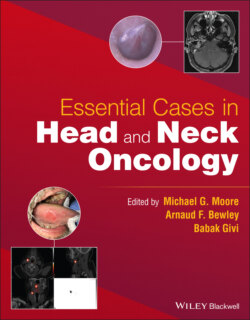Читать книгу Essential Cases in Head and Neck Oncology - Группа авторов - Страница 29
Management
ОглавлениеQuestion: What is the best way to achieve preoperative tissue diagnosis?
Answer: Punch/incisional biopsy. Since the lesion is easily accessible in the oral cavity, transoral incisional biopsy in the clinic is the most appropriate and expeditious way to get a tissue diagnosis. Fine needle aspiration of the lymph node may also be performed. However, a negative cytology from the lymph node does not rule out malignancy. Any consideration of an open biopsy of the lymph node should be avoided as it can complicate further neck treatment.
Question: What would be the most appropriate next step in the evaluation of this patient?
Answer: Considering the extent of the symptoms, imaging is recommended. CT scan of the head and neck with contrast is the most appropriate first step. Mental paresthesia is an indicator of the involvement of the inferior alveolar nerve in the mandibular canal. CT scan with contrast is the most appropriate imaging modality to assess the extent of mandibular invasion and cervical lymphadenopathy. If proximal extension of the tumor along the mandibular nerve is a concern on CT scan, an MRI could be obtained. For advanced oral cavity cancer, distant imaging is recommended, in the form of a CT chest with contrast or PET/CT.
Contrast‐enhanced CT of the neck shows a 4.5 cm heterogeneous tumor centered in the left retromolar trigone with underlying osseous destruction through the inferior alveolar canal. The erosive component of the tumor crosses the midline at the mandibular symphysis (see Figure 4.2). There are multiple enlarged and round lymph nodes in the left neck, the largest measuring 3.1 cm in left level 1b.
Chest CT does not demonstrate any distant metastatic disease.
The incisional biopsy came back as moderately differentiated SCC.
Question: What is the clinical tumor stage?
Answer: cT4aN2bM0, stage IVa. Mandibular involvement upstages the T stage to T4a. With multiple ipsilateral nodes <6 cm, the N stage is N2b.
FIGURE 4.2 CT scan shows an extensive and destructive process of the left mandibular body.
Question: What course of treatment would you recommend?
Answer: Treatment of advanced oral cavity SCC requires extirpation of the primary tumor with negative margins and addressing the lymphatics of the neck. Segmental mandibulectomy is required to obtain negative primary site surgical margins. The mandibular defect will require free tissue transfer reconstruction. The ipsilateral involved neck will require a neck dissection, level I–IV (skip metastases to level V in oral cavity carcinoma are uncommon). As the lesion crosses midline anteriorly, it is appropriate to consider or perform a contralateral selective (level I–III) neck dissection.
Question: What are the potential functional deficits after surgical treatment?
Answer: While rare, injuries to the spinal accessory nerve (CN XI) resulting in shoulder weakness, and marginal mandibular branch of the facial nerve (CN VII) resulting in lower lip depressor weakness, can occur but are not an expected outcome in experienced settings. Left chin numbness is to be expected after a segmental mandibulectomy as the inferior alveolar nerve is transected during the extirpation. Injury to the hypoglossal nerve (CN XII) is also rare and would be considered a complication. Treatment of alveolar cancer is not expected to result in significant dysphagia or aspiration postoperatively. However, when resection extends across the midline anteriorly, resulting in detachment of the genial muscular attachments, some loss of function can be observed.
Final pathology shows a 4.2 cm tumor centered in the left retromolar trigone with mandibular invasion, extensive perineural invasion, and a deep positive margin. In the right neck dissection specimen, 0/8 lymph nodes are involved with the tumor. In the left neck dissection specimen, 6/32 lymph nodes are involved with the tumor. There is a 3.1 cm level 1b lymph node that shows extranodal extension into the submandibular gland.
Question: Based on the final pathology, what is the pathologic stage and your recommended adjuvant treatment regimen?
Answer: pT4aN3bM0, stage IVb. Mandibular involvement results in pT4a staging. Any node with extranodal extension (ENE) results in an upstaging to N3b. There are many indications for radiation, including positive margins, perineural invasion (PNI), and multiple nodes involved. There are two indications for chemotherapy: positive surgical margins at the primary site and extranodal extension. In this case, considering that a large resection was performed and the defect is reconstructed with fibula flap, the expectation of re‐resection is not realistic. Therefore, continuing with concurrent adjuvant chemoradiation with platinum‐based agents is appropriate.
